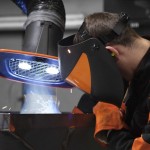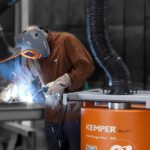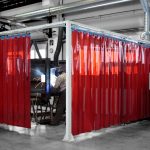After the transitional period for the General Dust Exposure Level: for health-based occupational safety
In 2014, legislators in Germany lowered the General Dust Exposure Level by more than 60 percent. Under certain conditions, factories were able to continue operating at the old limit of 3 mg/m³. This transitional period ended at the turn of the year. This has repeatedly sparked many discussions amongst those affected, but above all it has created uncertainty. This period is finally over – with a plea for health-based occupational safety in each country.
Finally, we can once again reflect on what really counts in occupational safety: the health of staff. This includes the resulting need for effective measures with regard to occupational safety. Discussions about occupational safety following the lowered General Dust Exposure Level in metalworking companies has been put on hold for nearly five years — FIVE YEARS.
A review: In April 2014, legislators published the details for the lowering of the General Dust Exposure Level for respirable dusts in the Federal Law Gazette. This laid down the tightened limits in the occupational safety regulations. Instead of 3 mg/m³ as before, factories have since been obliged to comply with a maximum hazardous substance exposure of 1.25 mg/m³, measured over an average eight-hour working day. This value was determined on the basis of new occupational health findings.
General Dust Exposure Level: Lowered by more than 60 percent
A reduction of more than 60 percent should be a straightforward matter. What this reduction actually brought about was, however, a matter of uncertainty. This was due to the transitional period before the new limit came into force. This was to ensure that companies that had already installed ventilation systems, such as extraction equipment, prior to the reduction would be able to protect their investments. It was only at the end of 2018 that these companies had to bring their extraction technology up to date.
This raised many questions: Does the General Dust Exposure Level now apply to us? Can I still go back to the old limit? Up to and including: Then it will be enough if I only use extraction systems in my production facilities from 2019 onwards? There was a great demand for consulting services during this period. But one thing was already clear before the introduction of the new rules and during the transitional period: Without effective extraction techniques in place, metal processors would not be able to maintain their operations legally.
With the start of the new year, the transitional period is now history. The General Dust Exposure Level of 1.25 mg/m³ for respirable dust now really does apply to every company. And we have to say: Finally, we have a clear legal position! But please do not misunderstand us. The end of the discussion on limits does not mean the end of discussing effective occupational health measures.
A plea for health-based occupational safety
Ever since our founding, we at KEMPER have been campaigning for a serious discussion on health-related occupational safety. Our focus is not on the law, but rather on healthy staff. At the time of our establishment in the late 1970s, there were no legal regulations to protect employees. Using our knowledge of the health hazards of welding smoke or cutting dust, right from the beginning we tried to make decision-makers in companies aware of occupational safety issues. Those who recognized the need for OSH early on were anticipating the legal developments.
Today, occupational safety is a matter of course. There are still welders — especially those of the older generation — who doubt if it is needed. But as a rule, companies have recognized the benefits of using extraction technology.
Of course, occupational safety is a cost factor. This not only includes the one-time investment costs, but also ongoing operating costs arising from such equipment as extraction and filtration systems. Companies that actively practice occupational safety not only incur equipment costs but also other costs associated with, for example,
- carrying out and, of course, implementing risk assessments
- ongoing maintenance of risk assessments
- training staff
But these costs can be mitigated to some extent. The state promotes energy-efficient plant technology. In addition, one thing is certain: The benefits clearly outweigh the costs.
Extraction technology eliminates dangers to health arising from welding fumes
Staff health: The health of employees comes first. The overarching goal is that hazardous substances should be prevented from passing into the air in the workshop by using effective occupational health and safety measures. Welding fumes and comparable cutting dusts are harmful and can have devastating effects on the human body, This is a fact that has been confirmed by numerous studies and is constantly being underpinned by new research. The World Health Organization classifies welding fumes as carcinogenic. The use of effective extraction technology in metalworking plays a key role in occupational safety, since other measures are not sufficient.
The longevity of welding and cutting machines: In any discussion about the benefits of occupational safety, the effect of extraction technology on the longevity of surrounding production machinery is not to be underestimated. Fine dust particles that make up welding fumessettle practically everywhere thanks to their light weight. So not only are they deposited on production machinery and in the immediate surroundings, but also in more distant locations. When they settle, they are not only visually unattractive, but also affect the functionality of plant — even causing it to break down.
From a company’s perception: Extraction technology is a technology of the future. The demand for extraction systems is increasing the world over. Employees, especially the younger generation with their awareness of occupational health and safety, are now paying close attention to how companies are equipped to deal with it. In the future, only those who take the right stance on occupational safety will be perceived as progressive employers The use of extraction technology not only benefits the employees themselves, but also customers. In the context of ongoing discussions about sustainability, in future customers will also be asking about the company’s position and how it deals with its employees. Those using extraction technology will have a clear advantage.
Employee recruitment and retention: Practicing occupational safety brings with it an image that will be a competitive advantage when courting the skilled workers of tomorrow. Metal workers, such as welders, are in demand as specialists. Here, the shortage of skilled workers has already long been felt. Only those companies who make themselves ready for the future can secure the competitiveness of their businesses.
So let’s stop talking about the law, and get down to discussing health: There will be further tightening of these limits in the future – that much is already certain. In the so-called specific limit values, there are already significantly lower specifications compared to the General Dust Exposure Level. But that should not distract us from the facts: Extraction technology and its benefits are useful not only for legal reasons, but for employee health in particular and thus the business itself!








